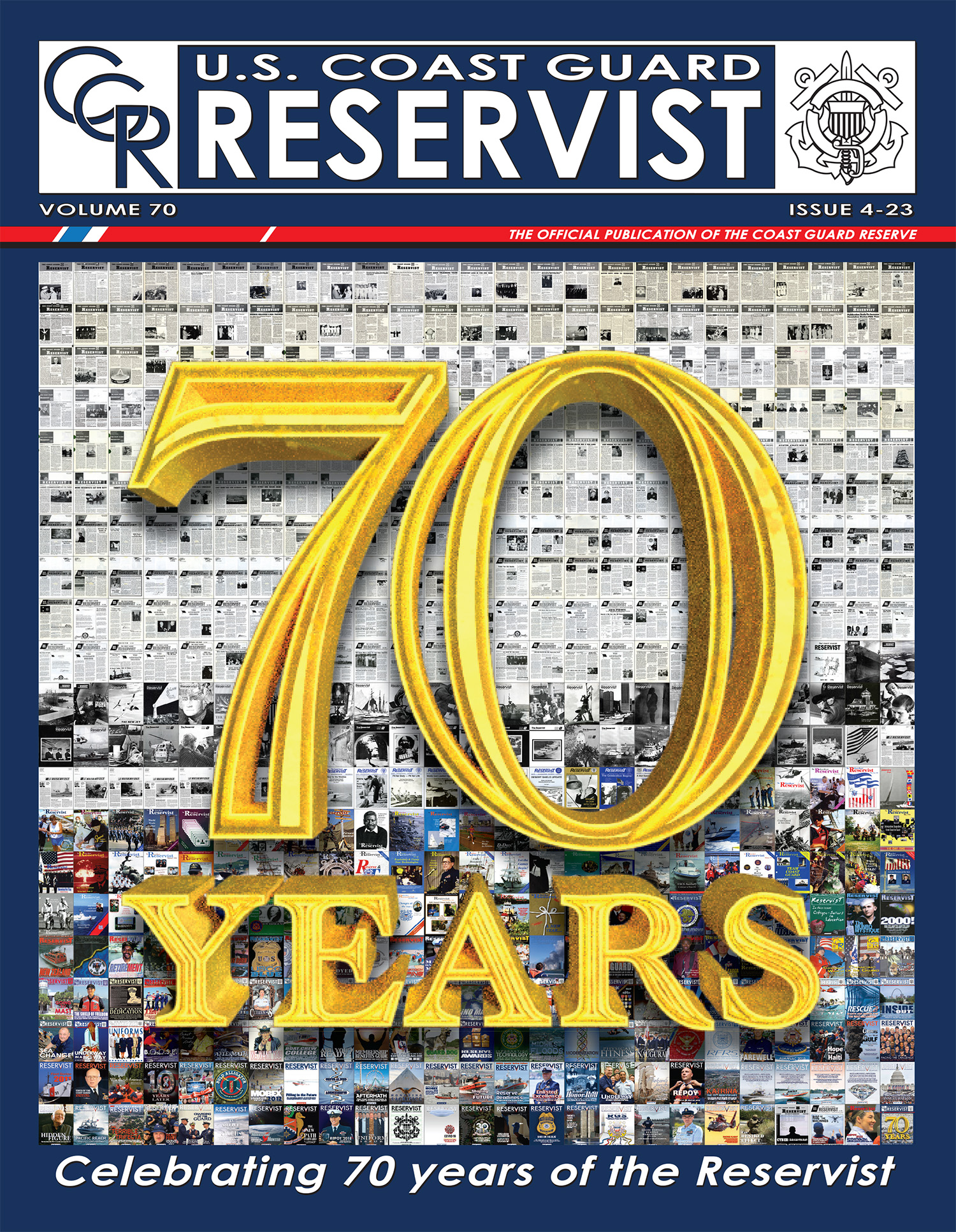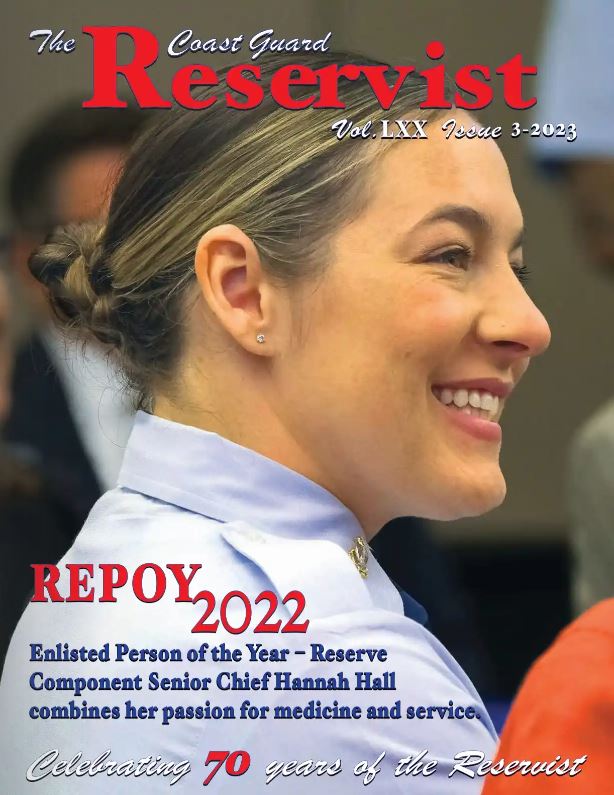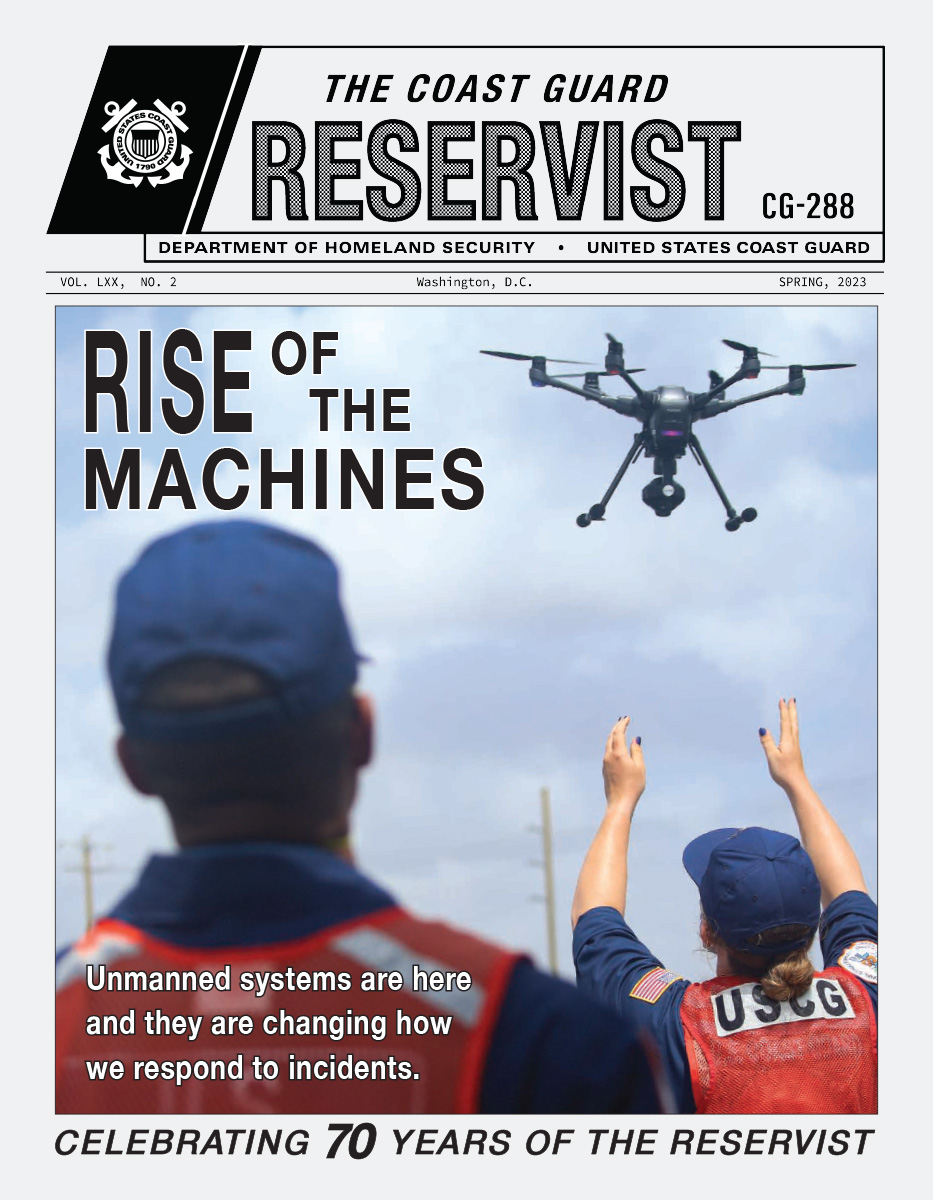 From the Assistant Editor:
From the Assistant Editor:
With over 15 years of combined service, both as an active-duty member and as a reservist, it's no secret that I'm committed to the Coast Guard's missions.
My husband, Cody, is an active-duty machinery technician. In 2022, he received orders down to North Carolina, which led me to take a billet as a reservist at a neighboring station. Prior to taking active duty orders at headquarters, I was encouraged to participate in the spring 2023 Chiefs' Call to Initiation with the Crystal Coast Consolidated Chief's Mess by my officer in charge.
The decision to participate in CCTI-only a week after advancing to chief-led me to a new network of friends and colleagues at the Special Mission Training Center as half of my CCTI group was attached to the unit.
I initially thought the tactical side was a little intimidating with their green uniforms, unbloused pants and unfamiliar acronyms-I was doing a lot of internet searches. I found out that almost a third of the uniformed members assigned to SMTC are reservists on active-duty orders. At the end of CCTI, I knew that SMTC's mission, and the story of the reservists who support it, was something that should be shared.
Petty Officer 1st Class Scott Turner, our videographer, and I had the opportunity to spend a week at SMTC capturing footage and engaging with the instructors and staff who train our tactical and expeditionary forces. Their passion for the mission was infectious.
Ensign Amanda Rousseau, a reservist and prior chief boatswain's mate from my CCTI group, spearheaded organizing our engagement with the unit. Thank you!
As for my decision to go through CCTI? I learned a lot about myself and how to mitigate stress. It was a lot to juggle as a drilling reservist, but I don't regret the long drives, early mornings, and the sometimes heroic effort to secure childcare.
What I ultimately learned was that we cannot and should not do everything alone. We cannot conduct boardings, respond to search and rescue cases or even publish a magazine by ourselves.
CCTI exposed me to a living repository of information, a group of people that create community through their knowledge and shared experiences. This is the same camaraderie I see throughout the Reserve, regardless of rate or rank.
The Coast Guard Reserve is small, and we rely on each other for guidance. I see reservists everyday supporting each other through challenges, celebrating triumphs and offering assistance when needed.
The last few months have been incredibly fun and challenging in developing the last two issues. With the return of the editor, Anastasia Devlin, I conclude my time with the magazine, but I won't be far! I'm joining the team permanently as a civilian, continuing to share the story of our component and our reservists.
If you have events going on at your unit, pictures you want to share or people you want to highlight, please contact me at: thereservist@uscg.mil.
Chief Heather Scheer, Assistant Editor
Click cover image to download a printable.pdf
 From the Assistant Editor:
From the Assistant Editor:
Greetings Reservist readers! My name is Heather Scheer, and I’m currently the Assistant Editor to the magazine. Ms. Devlin is on Active Duty for Operational Support (ADOS) providing assistance to units and families navigating the processes around the death of a service member in Decedent Affairs.
This past June, I was selected for an ADOS position to augment a social media and strategic communications position within CG-R55, allowing me this opportunity with the magazine. As a boatswain’s mate, not many people would have connected me with public affairs and social media. While my rating has forward-facing public interactions, people generally assume we lack the finesse to editorially wow the masses... It’s okay, we have a sense of humor too! That’s what is so amazing about the Coast Guard Reserve: it allows the opportunity for us to leverage our civilian skill sets to maximize the efficiency of our component.
I have a strong background in non-profit outreach and social media. Combined with my educational background in Leadership and Organizational Change, I was incredibly excited for the opportunity to work in Strategic Communications (STRATCOM) with the Reserve. I was also looking forward to learning the “whys” and “hows” of Coast Guard Reserve policy as members from small boat communities don’t often have the opportunity to work at Headquarters.
STRATCOM is multifaceted. We take messaging from Headquarters and push it out to the fleet, but we also siphon what we learn from the deckplate and route it back. Clean routes of communication are sometimes what reservists need most, and it is our goal to facilitate those connections. We’re currently engaging with an online platform of reservists for the purpose of support and collaboration on the challenges and triumphs of our members.
Right now, the Coast Guard finds itself in a personnel deficit with the Reserve shouldering a great deal of responsibility and commitment to mission readiness for not only our component, but the active-duty as well. As the Reserve helps to bridge these gaps, we are looking at new ways to leverage the expertise of our members. From leveraging civilian skill sets, to finding ways to improve systems and processes to make it easy for reservists to drill and respond, reservists are leaving an indelible impact on the Service and we want to share your stories and celebrate your contributions.
Take for example Lt. Cmdr. Pamela Tirado. An attorney, Tirado is highly educated, motivated and resourceful. She’s currently with Coast Guard Legal and activated to the Accountability and Transparency Review Team, ensuring a judicial eye is maintained through the process. We also went to college together 15 years ago... small Service, smaller Reserve!
I came onboard to CG-R55 with Petty Officer 1st Class Scott Turner. Originally a yeoman, Turner recently lateralled to a public affairs specialist. His professional experience as a videographer, along with his education and training, allowed him to seamlessly transfer into another rate. He is now creating a docuseries for the component.
I’ve also had the pleasure of meeting Chief Kevin Grant, Reserve Training Petty Officer at Station Point Judith. Grant runs the Warwick, R.I. police department’s boat program, cross-decking best practices to ensure efficient and effective training of search and rescue (SAR) components on Narragansett Bay- making the Coast Guard more efficient in SAR response.
Reservists offer a fresh perspective and best practices from civilian industries by leveraging their professional skills. I’m proud to see the component evolve and be recognized as the force multiplier we already know it is.
Chief Heather Scheer, Assistant Editor
Click cover image to download a printable.pdf
 From the Editor
From the Editor
As I make my way around Headquarters, I see signs constantly with the logo of the Commandant's Intent, which was released last summer at the change of command. There's a great tagline that says "Tomorrow looks different. So will we."
I've seen this tagline on briefing slides, pamphlets, and websites. And, though ubiquitous, it's still motivational every time I read it.
It's the right sentiment, because people seem to be so hungry for change. The leaders at the top want it; the operators on the ground are excited for it. We've been hearing it for the last year, so it feels like it's just around the corner.
But who goes first? Who makes the first move to look different?
I've heard talk about this "frozen middle," the senior enlisted, the commanders and captains, the senior civilians who may be hesitant to change up the process. But in their defense, these folks also are the ones who take the most amount of heat when things go wrong. They are the ones who must deal most directly with the fall out when administrations change, goalposts get moved, or staff turns over without much notice.
Just some grains of salt in a landscape peppered with opinions these days.
You know, a few years back, I was on active duty for a joint operation, and I met a fellow public affairs officer, a sharp Army captain. As we worked our way through ops, we'd occasionally compare and contrast how our services operated, but there was at least one commonality: how hard it was to find solutions that worked across different offices. That was the first time I ever heard the phrase "silos of excellence," indicating that each division or directorate or command had secured things within their own scope of authority, without recognizing that their solutions often created problems for operators in other divisions. They controlled and secured what was within reach, and trained people below them, ensuring the silo effect carried into the next generation of leaders.
This phrase, whether it's about silos or stovepipes, has been around for at least a decade, and it's likely found farther back in similar sentiments, both in government and in industry.
However, the problem of silos is compounded by low (and shrinking) tolerance for failure over the last 20 years or so, ensuring leaders (in the middle) tighten control, rather than reach for innovative (or collaborative) solutions, trusting their people.
"Silos of excellence" stays with me, and it's something I watch out for when the good idea fairy pops their head into a meeting. It's also something I look for when I am creating my own solutions. Am I part of the frozen middle? In what ways have I gotten creative lately, and to whom have I reached out to share in the past few months?
If you're not changing, you're not growing, and change at this pace is difficult. The cultural problems on top of it are daunting, but not impossible.
We won't be the first or the last to deal with this culture problem, but change is slow, and our patience can be thin. Finding that safe zone where change starts, allowing our motivated young leaders to try new things takes courage and contagious calm.
Teddy Roosevelt had the right idea when he said, "In any moment of decision, the best thing you can do is the right thing, the next best thing is the wrong thing, and the worst thing you can do is nothing."
Sounds cynical, but it's not. I'm just one person looking forward to great things coming from this organization. The talent we continue to bring in has good ideas, and they're sharp as tacks. Nowhere to go but up!
Anastasia Devlin, Editor-in-Chief
Click cover image to download a printable.pdf
 From the Editor
From the Editor
Before you ask the question I know you’re all wondering, yes, this is still the Reservist magazine you’ve always known and loved.
We look a little different this issue, don’t we? You must have looked askance at the top of your magazine without recognizing our traditional banner—unless you’ve been receiving it, as some of you have, for the last 70 years. So maybe, for you salty dogs, our banner from the 1950s was just a little shot of nostalgia!
Well, from our humble beginnings back in November 1953, we’ve come a long way. This magazine started as a four-page, black-and-white newsletter with a few photos thrown in for good measure. You may have seen the occasional cartoon or advertisement. In our archives, I’ve even seen a questionable feature about which sailor had the prettiest sweetheart! Informative AND entertaining.
However, somewhere around the early 1990s, under the early editorship of Petty Officer 2nd Class Ed Kruska, it developed into a slim but robust monthly magazine. As he made his way to chief warrant officer, this little publication also advanced, blossoming into a pretty sturdy quarterly magazine full of photos and essential information.
The magazine itself has seen a lot of change in seven decades.
We’ve seen a layout process involving typewriters, glue and dark rooms turn into interactive stories linked to videos and social media handles.
We’ve tracked Summerstock from its inception 50 years ago, watched Reserve integration become the norm, seen many a dark day after the attacks of 9/11, and observed changes in our Service brought by the world wide web from its earliest days of dial up.
Those pictured among the pages used to sport the Donald Duck style hat or even old-timey dungarees; maybe you caught a glimpse of the chiefs in their khakis—heaven forbid, you may have even seen a beard or two in an old, old issue! And then, ladies in uniform appeared more and more regularly in the pages, and the words “enlisted men” went the way of the dinosaurs.
What a wild ride we’ve had in our 70 years.
You’ve known us as “ The Coast Guard Reservist,” “Coast Guard Reservist,” “Reservist Magazine,” and finally, “Reservist,” but our original vision and purpose never changed.
This is still your beloved, informative source of the latest developments and achievements of the Coast Guard Reserve. As I’ve always said, we try to make it easier for reservists to understand the opportunities found in the Coast Guard, while also showing the Coast Guard the caliber and hidden talents of its reservists.
As they say, the only thing constant is change.
After all, what is the Coast Guard Reserve known for, if not its adaptability? We learn, we grow, and we take on new challenges.
Reservist is the same way.
In fact, I’ll warn you now, the cover of this magazine will not look the same next issue, or the issue after that. Through the end of this year, we’ll be honoring the changes the banner of the magazine has gone through since our establishment just after World War II. But in 2024, you’ll see our new look.
As we look forward to our next decade, what changes would you like to see? I’m already hearing requests for a new ribbon chart, a story on the new Type III uniform coming out, and a dedicated retirement issue.
Stay tuned for the latest.
Anastasia Devlin, Editor-in-Chief
Click cover image to download a printable.pdf